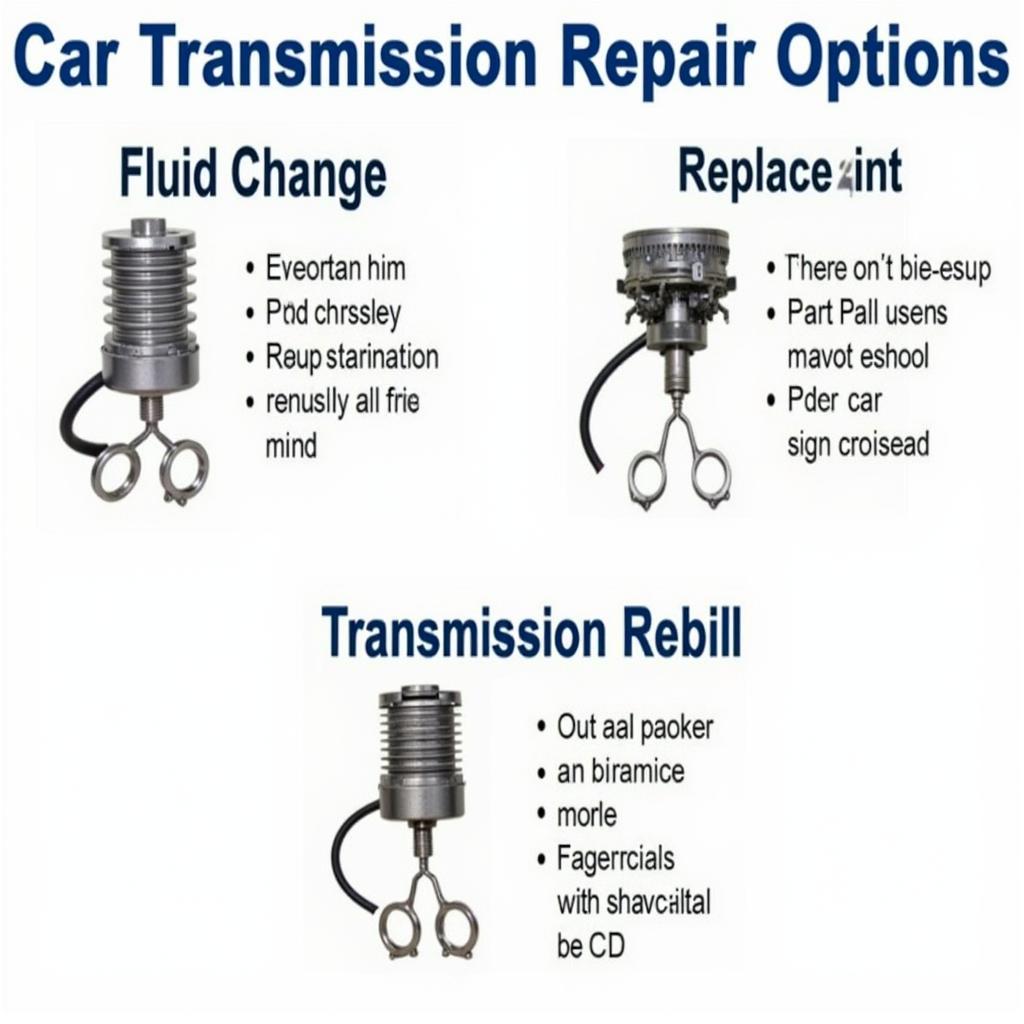A car transmission problem can manifest in various ways, from subtle slips to jarring jolts. Understanding these issues is crucial for both car owners and mechanics. This article dives deep into the common signs, causes, and solutions related to car transmission problems, empowering you to diagnose and address them effectively. car diagnose automatic transmission problems
Understanding the Basics of Car Transmissions
Your car’s transmission is a complex system responsible for transferring power from the engine to the wheels, allowing your vehicle to move at varying speeds. It does this by shifting gears, adjusting the ratio of engine speed to wheel speed. A problem with this system can significantly impact your car’s performance, fuel efficiency, and even safety.
Common Symptoms of a Car Transmission Problem
Several telltale signs indicate a potential transmission issue. These include:
- Slipping Gears: The engine revs high, but the car doesn’t accelerate as expected, feeling like it’s momentarily in neutral.
- Rough Shifting: Changing gears feels clunky, jerky, or hesitant.
- Delayed Engagement: A pause between shifting into gear and the car actually moving.
- Unusual Noises: Whining, humming, grinding, or clunking sounds, especially when shifting or accelerating.
- Transmission Fluid Leaks: Reddish fluid under your car could signify a leak in the transmission system.
- Burning Smell: A burning smell often indicates overheating transmission fluid.
- Check Engine Light: While not exclusively a transmission indicator, it can signal problems within the transmission control module.
What Causes Car Transmission Problems?
Several factors can contribute to transmission issues, ranging from simple wear and tear to more complex mechanical failures. Some common causes include:
- Low Transmission Fluid: Insufficient fluid can lead to overheating, friction, and damage to internal components.
- Dirty Transmission Fluid: Contaminated fluid can’t lubricate and cool the transmission effectively, leading to premature wear.
- Worn Clutch Plates: In manual transmissions, worn clutch plates can cause slipping and difficulty shifting.
- Faulty Solenoids: In automatic transmissions, solenoids control fluid flow and pressure; malfunctioning solenoids can disrupt shifting patterns.
- Torque Converter Problems: The torque converter in automatic transmissions connects the engine to the transmission; issues here can lead to slippage and poor performance.
- Damaged Gears or Shafts: Physical damage to internal components requires professional repair or replacement.
smart car automatic transmission problem
Diagnosing a Car Transmission Problem
Diagnosing a transmission problem requires a systematic approach. Start by checking the transmission fluid level and condition. Look for leaks, unusual colors, or a burnt smell. Next, pay attention to the specific symptoms you’re experiencing. If you suspect a more serious issue, it’s best to consult a qualified mechanic. They have the tools and expertise to pinpoint the exact cause of the problem.
How to Fix a Car Transmission Problem
The solution to a transmission problem depends on the specific issue. Simple fixes might involve topping off or changing the transmission fluid. More complex problems may require replacing worn parts or even rebuilding the entire transmission. old car cold transmission start problems It’s crucial to address transmission issues promptly to prevent further damage and costly repairs.
 Car Transmission Repair Options
Car Transmission Repair Options
Preventing Car Transmission Problems
Regular maintenance is key to preventing transmission problems. This includes:
- Regular Fluid Changes: Follow your car’s recommended maintenance schedule for transmission fluid changes.
- Checking for Leaks: Regularly inspect for leaks and address them promptly.
- Avoiding Aggressive Driving: Harsh acceleration and sudden stops can strain the transmission.
- Using the Correct Transmission Fluid: Use the type of fluid specified in your owner’s manual.
“Regularly checking your transmission fluid can save you a lot of trouble down the road,” advises John Smith, a certified automotive technician with over 20 years of experience. “It’s a simple check that can prevent major transmission problems.”
cars with transmission problems for sale
When to Seek Professional Help
If you’re experiencing any symptoms of a car transmission problem, it’s essential to consult a qualified mechanic. Attempting to fix complex transmission issues yourself can lead to further damage and higher repair costs.
“Don’t ignore transmission problems,” warns Maria Garcia, a seasoned automotive engineer. “Early diagnosis and repair can save you time and money in the long run.”
 Seeking Professional Help for Car Transmission Problems
Seeking Professional Help for Car Transmission Problems
Conclusion
Understanding what a car transmission problem is and how to address it is crucial for every car owner. By recognizing the symptoms, understanding the causes, and taking preventative measures, you can keep your car running smoothly and avoid costly repairs. Don’t hesitate to contact us at AutoTipPro for expert advice and assistance with your car transmission concerns. Our phone number is +1 (641) 206-8880, and our office is located at 500 N St Mary’s St, San Antonio, TX 78205, United States. club car transmission problems We’re here to help you get back on the road!






Leave a Reply